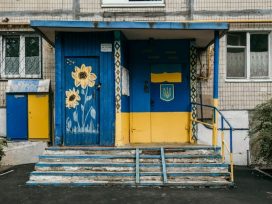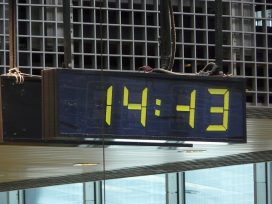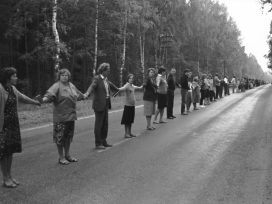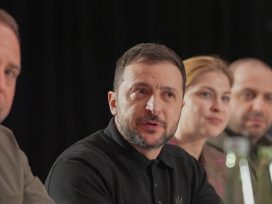A caring community of fate
Ongoing discourse about a collective Belarusian identity since the 2020 protests tend to circle around nationalism. Those who oppose the regime and managed to escape are calling for horizontal societal structures, in solidarity with those imprisoned. Belarusian culture is more than language; it includes human rights, economic interests and everyday narratives.
Resurgent debates about nationalism and national identities have become a hallmark of the twenty-first century. Right-wing populists with enhanced political standing around the world came first, pushing narratives about ‘pure’ national communities, blaming migrants for economic inequality and social injustice.1 Then Russia’s full-scale invasion of Ukraine refocused the debate, bringing back discussions of national liberation wars and, more broadly, of the relationship between nationalism, imperialism and war. Belarusian society, too, has not been immune to ongoing deliberations about collective identity, which gained renewed impetus after the massive protests of 2020.
Solidarity versus unified collective self-consciousness
Scholars of contemporary Belarusian national identity speak of it as weak, contradictory or problematic.2 Among the reasons given in Toward a New Belarus is the population’s failure to agree on ‘the cultural and historical distinctiveness of the Belarusian nation’, focusing on the Belarusian language as a key element in national identity.‘3 Fillip Bikanov takes the ‘unity of the Belarusian nation’, which implies ‘a self-consciousness marked by common features and a shared relationship to national culture and history’, as his normative framework for investigating Belarusian national identity.4 The varying, discordant concepts Belarusians hold about their culture and history are seen as evidence of a weak collective identity.
In 2017, however, Maryia Rohava proposed a different way of approaching Belarusian national identity. Based on her own qualitative sociological research, she identified many layers to Belarusian ‘everyday nationalism’. Instead of collective self-consciousness, she emphasized Belarusians’ practices of quasi-public conversation about their national identity. Among the layers she brought to light were geographic and historical imagination, affiliation with a political community, culture as a feeling of identification with state or oppositional symbolism, and consumption practices. Rohava used the term ‘hybrid identity’, or conflict among various discourses of identity, to designate the diversity of these layers and the links between them. And at the very end of her analysis, she drew the conclusion that ‘future protests in Belarus will more likely be oriented toward a variety of problems rather than relying on questions of (cultural) identity, the way they have in previous years.’5
Indeed, that is what happened. An unprecedented consolidation of Belarusian society took place in 2020: the Belarusian anti-authoritarian protest, as reported by the Belarusian Institute for Strategic Studies (BISS), ‘ranks among the 15 largest and longest mobilizations among more than 100 countries in 50 years. Even the Ukrainian mobilization of 2014 and the Venezuelan mobilization of 2017 are lower in some parameters to the Belarusian one.’6 And the protest wasn’t based on a coherent narrative about a shared historical past or a choice exclusively favouring the Belarusian language. Multiple intersecting practices for achieving horizontal solidarity were the driving force. They were what brought such disparate social groups into the streets across the entire country for more than 100 days. And they have not lost their importance today: the diaspora aids Belarusian political prisoners and reaches out to Ukrainians, both those fighting on the frontlines and refugees).
Politician Maria Kalesnikava’s expression ‘We Belarusians are incredible’ and the heart sign she made with her hands were important symbols for this solidarity. Kalesnikava, a musician and cultural administrator by profession, chaired the electoral campaign for Viktar Babaryka, who, in receiving 400,000 votes, became the Republic of Belarus’ most popular presidential candidate in 2020. When the regime put him in jail, Kalesnikava started supporting Sviatlana Tsikhanouskaya, who was running in place of Sergei Tikhanvsky (Tsikhanouskaya’s already-jailed husband). In organizing a united women’s campaign group, Kalesnikava, Tsikhanouskaya and Veranica Tsapkala, another political activist, managed to mobilize Belarusian society in unprecedented numbers.
The heart and slogan signalled recognition for the contributions representatives of widely disparate social groups made to the protests, showing appreciation for their efforts, their creativity, and the inherent risk of going out into public space and taking part in collective action. These actions echo the Arab Spring revolutions. Scholar Asef Bayat reflected on how many normal people – elderly and adolescents, mothers and grandfathers, little sisters or brothers, the poor and the better-off – become exceptional, transforming into those who go beyond the limits of their everyday activities to join organizations for social action, collect signatures, create posters, or aid victims of violence. ‘The key to the birth of the collective agency is the spirit of the moment, a sudden extraordinary constellation of voices, networks, and energies that activates overlapping interests and positionalities and renders disparate subaltern groups to share a feeling of collective pain and prospect.’7 Precisely this transformation drives diverse groups of voters beyond their sectoral interests and emboldens them to join a single movement of citizens pressing for broader demands.
Curator Antonina Stebur and artist Aleksei Tolstov use the umbrella term ‘infrastructure of care’ to denote practices for achieving solidarity that take in the whole of Belarusian society. In their opinion, where structures like professional unions that could have supported the protests are absent and ‘in a situation where the life of every citizen is unstable and fragile, care becomes both a central political impulse and a programme’. An infrastructure of care unites society without erasing differences and politicizes without establishing a monopoly on power.8 The BISS researchers cited earlier located the preconditions for forming this infrastructure when they pointed to the rising ethos of cooperation in Belarusian society since 2010.9
‘People who live here’
The most important and lasting expression of united Belarusian resistance to authoritarian state violence in 2020 and beyond is the demand of respect for human dignity or li͡udz’mi zvatstsa (the right ‘to be called people’).10 This demand, as I demonstrate in my book on the Belarusian revolution of 2020, united people participating in different kinds of protest across Belarus.11 li͡udz’mi zvatstsa, from a line in Yanka Kupala’s now classic poem A khto tam idze? (And Who Goes There?, 1905-1907), is accompanied by another concept the poet promoted: tutėĭshasts’ (people who live here), which resonates with our current understanding of hybrid Belarusian identity.

Jacob’s Dream, Marc Chagall, 1960-66, Photo by Rokus Cornelis, CC BY 3.0, via Wikimedia Commons
This concept – or identity – alludes to how Belarusians from the end of the eighteenth century to the beginning of the twentieth century referred to themselves as ‘people who live here’ (or locals) rather than as people who belong to a specific nation. The concept’s use was conditioned by the fact that different portions of Belarusian lands were historically annexed to a variety of Central and Eastern European state formations: the Great Principality of Lithuania, the Polish-Lithuanian Commonwealth, the Russian Empire and the Soviet Union. Borders shifted and ‘titular nations’ came and went. As Aleksandr Pershai writes, ‘different population groups – and sometimes different generations – came to understand “their own” culture, language, religion, laws, literature, and so on, in different, “uneven” ways.’12 According to Alena Minchenia and Nadzeya Husakouskaya, precisely tutėĭshasts’, and not Belarusian national identity, generated solidarity and enabled the creation of broad alliances in 2020 by expressing the type of community that arises for the purpose of uniting ‘in times of great uncertainty, horrendous state violence, and the sense of urgency, solidarity and mutual aid’.13
The demand ‘to be called people’ also echoes the guiding slogan of the Ukrainian revolution of 2013-2014: the demand of respect for human dignity. Francis Fukuyama places this demand central to a liberal, democratic, inclusive version of nationality for providing a way, in an era of diversity, to move beyond ubiquitous varieties of identity politics toward ‘broader forms of mutual respect for dignity that will make democracy more functional.’14
Such a demand might be formulated in the language of a stable cultural identity with requisite references to the distant past, understood in an unambiguous fashion, but this kind of formulation is hardly definitive. Professional groups can formulate the demand of respect for human dignity in terms of equitable, legal and democratic rules for regulating the labour market and defending their collective interests. Women can formulate it in terms of the struggle for gender equality. And the elderly can invoke the struggle to eradicate ageism from society for a dignified old age.
Another example in Belarus is the current struggle against linguistic discrimination or, more precisely, discrimination against those who choose Belarusian as their main or only language. Debates about how to treat a diverse Belarusian cultural heritage (e.g., Marc Chagall and Adam Mickiewicz) – how to understand it, what to include and what values should provide the basis for interpreting it – intersect at particular points within these diverse forms of struggle but cannot replace them. As sociologist Gerard Delanty writes, ‘cultural identities are becoming more hybrid and political identities are less separated from cultural identity. Today cultural diversity rests less on ethnic heterogeneity – the pluralism of cultural forms of life – than on the emergence of new sub-cultures based on class, gender, religion and lifestyles shaped by consumption.’15 Consensus on Belarusian collective identity and its consolidation are work in progress; Belarusian culture includes not only heritage but also human rights, economic interests and everyday narratives.
The community of fate, today
The 2020 revolution, however, added a crucial element to the Belarusian experience of identity: our experience of violence and the broad horizontal unity aimed at withstanding threats transformed Belarusians into a community of fate. The need to care for the imprisoned – there are at least 1,700 political prisoners at present, including the aforementioned Maria Kalesnikava, Viktar Babaryka and Siarhei Tsikhanouski – and those subject to torture and persecution, or experiencing difficulties abroad continues to be both an extremely important theme in the life of this community and a thorn in the side of a regime that is still repressing Belarusian society.16 2020’s community of fate remains at the very epicenter of the everyday stories that Belarusians recount today, a crucial component in the formation of collective identity.17
But, as many Belarusian scholars have noted, 24 February 2022 posed a new challenge to this community of fate. The Belarusian regime provided the ‘Russian world’ with enhanced standing not just online but also physically by allowing the presence of Russian military equipment and soldiers on Belarusian territory. In response, a consolidated, homogenized version of nationalism began to gain ground, at least in speeches by certain political actors. In their understanding, there is only one method for pushing back against ‘Russian world’ propaganda: the mass development of Belarusian identity through a campaign supporting national revival.18 Since it is unclear what political actors plan to revive and since Belarus’ past, like that of any other country, contains violence and discriminatory practices, these formulations are a way of referencing populist nationalism (in Fukuyama’s version) and are unlikely to involve the critical thinking that could provide the antidote to any kind of propaganda.
As the 2020 protests have shown, Belarusian society has no shortage of ‘antidotes’ to the ‘Russian world’ – critique of patriarchy, ‘traditional values’, lack of police accountability and various forms of state violence – but it also exhibits ‘care’, the horizontal solidarity so feared by both ‘brother dictators’, who see humanitarians and defenders of human rights as their primary opponents (including Nobel laureate Ales Bialiatski, sentenced to 10 years in a maximum security penal colony in March 2023, and Marfa Rabkova, coordinator of Viasna Human Rights Centre’s Volunteer Service, sentenced to 14 years and 9 months, alongside many others). Together with support for these values and the practices that uphold them, a search for their sources in our past and an attempt to clothe them in meaningful symbolism can open the way to withstanding not only the ‘Russian world’ but also populist and authoritarian nationalism. These are fitting responses to the widespread democratic aspiration that crystallized in 2020. It has lost none of its significance today.
This subject is treated, for instance, in Francis Fukuyama’s Identity: The Demand for Dignity and the Politics of Resentment, New York, Farrar, Straus, and Giroux, 2018, where he distinguishes populist, authoritarian and democratic nationalisms.
Its contradictory nature is the subject, in particular, of a 2020 investigation by the Belarusian Institute for Strategic Studies (BISS), ‘K novoi Belarusi: faktory transformatsii,’ Vilnius, 2021, p. 56, (https://belinstitute.com/sites/default/files/2021-09/Toward%20a%20New%20Belarus.%20BISS%20Research.%20RU.pdf; in English: “Toward a New Belarus: Transformation Factors,” p. 51, https://belinstitute.com/sites/default/files/2021-09/Toward%20a%20New%20Belarus.%20BISS%20Research.%20EN_0.pdf). Fillip Bikanov states that ‘a significant portion of Belarusian society is at a crossroads with respect to its identity,’ in his ‘Belorusskaia natsional’naia identichnost’ v 2022 godu: opyt kolichestvennogo issledovaniia’ [‘Belarusian National Identity in 2022: An Essay in Quantitative Research’], Bonn and Berlin, Friedrich Ebert Stiftung, 2022, p. 52, https://library.fes.de/pdf-files/bueros/belarus/19770-20221206.pdf.
K novoi Belarusi,’ p. 55; ‘Toward a New Belarus,’ p. 53.
Bikanov, p. 4.
Maryia Rohava, ‘Identity in an Autocratic State. Or What Belarusians Talk about When They Talk about National Identity,’ East European Politics and Societies: and Cultures, Vol. 32, no. 3, August 2018, pp. 639-668.
‘K novoi Belarusi,’ p. 69; ‘Toward a New Belarus,’ p. 68.
Asef Bayat, Revolutionary Life: The Everyday of the Arab Spring, Cambridge, Harvard University Press, 2021, p. 37.
Antonina Stebur and Aleksei Tolstov, ‘Kak voda. Dinamika belaruskogo protesta: ot sushchestvuiushchego tekhnicheskogo bazisa k utopicheskim gorizontam budushchego’ [‘Like Water. The Dynamic of Belarusian Protest: From an Existing Technical Base toward Utopian Future Horizons’], å [Syg.ma], 05.09.2020, https://syg.ma/@antonina-stiebur-alieksiei-tolstov/kak-voda-dinamika-bielaruskogho-protiesta-ot-sushchiestvuiushchiegho-tiekhnichieskogho-bazisa-k-utopichieskim-ghorizontam-budushchiegho?fbclid=IwAR1IvVtEDKB4FbCnSsJlr2qCnSj7JMcpnzsGTtexPrD5unmH4xFzYkukDfk.
‘K novoi Belarusi,’ pp. 59ff; ‘Toward a New Belarus,’ pp. 58ff.
Bikanov, p. 26.
Olga Shparaga, Die Revolution hat ein weibliches Gesicht. Der Fall Belarus, Berlin, Suhrkamp Verlag, 2021, pp. 173-178.
Aleksandr Pershai, ‘Tutėĭshasts’ kak taktika kul’turnogo soprotivleniia: o lokal’nosti, sotsial’noi mobil’nosti i belarusskoi natsional’noi identichnosti’ [‘Tutėĭshasts’ as a Tactic for Cultural Resistance: On Being Local, Social Mobilization, and Belarusian National Identity’], Forum noveishei vostochnoevropeiskoi istorii i kul’tury [Forum on Emerging Eastern European History and Culture], Vol. 9, no. 2, 2012, pp. 251-268, http://www1.ku-eichstaett.de/ZIMOS/forum/inhaltruss18.html.
Alena Minchenia and Nadzeya Husakouskaya, ‘For many people in Belarus, change has already happened,’ openDemocracy, 19.11.2020, https://www.opendemocracy.net/en/odr/many-people-belarus-change-has-already-happened/.
Fukuyama, p. 133.
Gerard Delanty, Community, Second edition, London and New York, Routledge, 2010, p. 84.
On political persecution and the current situation in Belarus, see my article: ‘Die Frauen in der Strassen der Minsk,’ Die Presse, 10.04.2023, https://www.diepresse.com/6273428/die-frauen-in-den-strassen-von-minsk?from=rss
See, for example: Wolha Waloschkina, ‘In Belarus Leben,’ Dekoder, 13.10.2022, https://www.dekoder.org/de/article/waloschkina-zukunft-gegenwart-belarus
Aliaksandr Milinkevich, ‘Da chago gatovae belaruskae gramadstva i da chago musits’ rykhtavatstsa?’ [‘What is Belarusian society ready for, and what should it prepare for?’], Bank idei, 17.10.2022, https://www.ideasbank.vision/articles/15. ‘National revival’ became the United Transitional Cabinet’s chosen trajectory for cultural politics when it appointed Alina Koushik its ‘representative on questions of national revival’.
Published 27 June 2023
Original in Russian
Translated by
Thomas J. Kitson
First published by Eurozine
Contributed by Institute for Human Sciences (IWM) © Olga Shparaga / Institute for Human Sciences (IWM) / Eurozine
PDF/PRINTIn collaboration with
In focal points
Newsletter
Subscribe to know what’s worth thinking about.
Related Articles

Ukraine faces its greatest diplomatic challenge yet, as the Trump administration succumbs to disinformation and blames them for the Russian aggression. How can they navigate the storm?

The ongoing repression of Belarusian society now extends to the banning of literary works by Belarusian writers seen as seditious. The reason can only be that they offer the regime its true reflection, writes one of the country’s leading poets.






